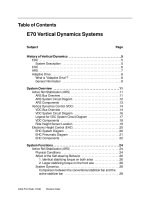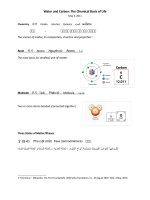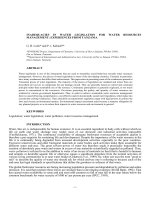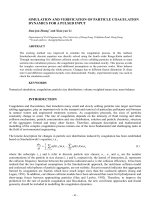- Trang chủ >>
- Khoa Học Tự Nhiên >>
- Vật lý
Global water dynamics
Bạn đang xem bản rút gọn của tài liệu. Xem và tải ngay bản đầy đủ của tài liệu tại đây (6.07 MB, 404 trang )
PREFACE
Hydrology has been almost taken over by mathematical modeling. However,
natural systems are multidimensional and multiparametric, and to understand them real data—observations and measurements obtained in real study
areas—are needed. The following are examples of the applied research
approach:
The three spatial dimensions are surveyed via a large number of sampling
and measuring points, e.g., springs, wells, drillings, geological surveys,
and more.
The time dimension is addressed by investigation of the geological and
hydrological dynamics of the system, e.g., by dating of the groundwater
host rocks, by isotopic dating of the water itself, and on the small scale
by seasonally repeated measurements.
Multiparametric observations and measurements include water table positions, water heads, water temperature, and an extended list of chemical
and isotopic analyses performed on carefully collected water samples.
The final picture of every study case is derived on the basis of a large
number of observations and derived conclusions.
Correlations between measured parameters are sought, as they provide indispensable insights into the studied systems, e.g., identification of
mixing of water sources; external origins of dissolved ions versus
water–rock interactions; temperature-induced processes; evaporation
effects; and processes such as dolomitization, de-dolomitization, and
absorption.
iii
iv
Preface
Spatial distribution of water facies, in depth profiles and between adjacent
wells or springs, sheds light on the occurrence of shallow throughflowing groundwater systems, and deeper isolated rock-compartments,
that contain fossil formation waters as well as oil and gas.
The book addresses topics related to groundwater exploitation and
preservation, petroleum genesis and exploration; thermal water recreation
and energy production; nuclear waste repositories; and the educational
aspects of these topics.
Emanuel Mazor
CONTENTS
Preface
Part I.
iii
The Geohydroderm and Its Major
Groundwater-Containing Geosystems
1. Water Propelled Geological Processes and Shaped the
Landscapes of Our Planet
1.1 Water—Earth’s Sculptor
1.2 Water—The Unique Fluid on Our Planet
1.3 The Special Properties of Water that Are the
Base of All the Phenomena Dealt with in this Book
1.4 Key Roles of the Oceans in the Dynamics of the
Global Water Cycle
1.5 Fresh Water Erodes Mountains but Exists Thanks to
Them
1.6 Formation Water, Entrapped in Isolated
Rock-Compartments, Has a Meteoric Isotopic
Composition and an Imprint of Evaporitic Brines
1.7 Location of Land and Sea Changed Constantly
1.8 Petroleum Hydrology
1.9 Earth Exhibits Rocks that Are Unique Resources
of this Planet—Products of Water-Induced Processes
1.10 The Dynamics of the Global Water Cycle Propelled
Biological Evolution
1.11 Summary Exercises
2
2
5
7
10
11
11
11
12
13
13
15
v
vi
2.
3.
Contents
Exploring and Understanding the Geohydroderm by
Sequences of Observations and Conclusions
2.1 Global Groundwater Research Within the
Geohydroderm
2.2 The Active Cycle of Fresh Surface Water and
Unconfined Groundwater
2.3 Interstitial Water Entrapped in Rocks Beneath the
Vast Oceans
2.4 Fossil Formation Waters Entrapped Within
Sedimentary Basins and Rift Valleys
2.5 Halite and Gypsum
2.6 Shallow and Deep Groundwaters Are Indispensable
Geological Records
2.7 Brine-Spray-Tagged Meteoric Formation Water Is
Also Common Within Crystalline Shields
2.8 Petroleum Occurrence and Genesis
2.9 Warm and Boiling Groundwaters
2.10 Summary Exercises
33
35
37
39
Basic Research Concepts, Aims and Queries, Tools, and
Strategies
3.1 Basic Research Concepts and Terms
3.2 Research Aims and Queries
3.3 The Research Tools
3.4 Research Strategies
3.5 Summary Exercises
41
41
44
53
61
63
Part II.
4.
16
16
18
24
27
31
31
Shifting of Water and Salts Between Oceans and
Continents
Shallow Cycling Groundwater, Its Tagging by Sea Spray,
and the Underlying Zone of Static Groundwater
4.1 Groundwater Facies of the Geohydroderm
4.2 Sea Spray Salts Concentrated Along a Large
River System—The Murray River Basin, Australia
4.3 Sea Spray Salts Concentrated in a Closed Lake System
Within an Arid Zone—Yalgorup National Park,
Australia
4.4 Sea Spray Salts Concentrated in Unconfined
Groundwater—Campaspe River Basin, Australia
4.5 Sea Spray-Tagged Fresh and Saline Groundwaters
in the Unconfined Groundwater System at the
Crystalline Shield of the Wheatbelt, Australia
66
66
68
75
76
78
Contents
4.6 Sea Spray Versus Brine-Spray Tagging
4.7 Sea-Derived Ions Serve as Benchmarks Identifying
Water–Rock Interactions
4.8 Gravitational Flow in the Unconfined Groundwater
System and Static Water Storage Beneath
4.9 Summary Exercises
5. Interstitial Waters in Rock Strata Beneath the Oceans
5.1 Extending Our Hydrological Curiosity to Beneath
the Oceans
5.2 The Deep Sea Drilling Project
5.3 Water Content in Suboceanic Sediments
5.4 The Widespread Marine Facies of Interstitial Water
(Cl f 19 g/L, Cl/Br f 300, Diagenetic Changes Are
Common)
5.5 Continental Brine-Tagged Facies: Salinity Higher
than Seawater Cl/Br 200 or Lower, Ca–Cl Present
5.6 Information Retrievable from Below-Ocean
Interstitial Waters
5.7 Interstitial Water is Connate Water, Entrapped
in Its Host Rocks Since the Initial Stage of
Sedimentation
5.8 Interstitial Waters Tagged by Brine-Spray Disclose
that the History of the Mediterranean Sea Basin
Included a Continental Stage
5.9 Geological Evidence Proves that the Mediterranean
Sea Underwent a Phase of Drying Up
5.10 Summary Exercises
6. Salt, Gypsum, and Clay Strata Within Sedimentary
Basins Disclose Large-Scale Evaporitic Paleo-Landscapes
6.1 Minerals Formed Along the Continuous
Evaporation Path of Seawater and Notes on the
Composition of the Residual Brines
6.2 Formation of Halite and Gypsum Deposits
Necessitated Evaporation of Tremendous Amounts
of Seawater During Extended Time Intervals
6.3 Evaporitic Paleo-Facies: Information Recorded by
Associated Formation Waters
6.4 The Permian ‘‘Saline Giant’’ of the Salado
Formation—An Ancient Evaporitic Megasystem
6.5 Evaporite Deposits Are Common in Sedimentary
Basins
vii
82
82
83
91
92
92
93
93
94
98
108
111
111
112
113
115
115
116
117
118
119
viii
Contents
6.6
Silurian Salt Deposits Were Not Dissolved by the
Nearby Formation Water
6.7 Recent Lowering of the Dead Sea Lowered the
Coastal Groundwater Base Flow and Initiated
Rapid Dissolution of a Buried 10,000-Year-Old
Halite Bed
6.8 The Many Preserved Salt Beds Manifest the
Preservation of Connate Groundwaters
6.9 Limestone–Clay Alterations Reflect Alternating Sea
Transgressions and Regressions
6.10 Summary Exercises
Part III.
7.
8.
120
121
122
123
123
Deep Groundwater Systems—Fossil Formation
Waters
The Geosystem of the Fossil Brine-Tagged Meteoric
Formation Waters
7.1 Formation Waters Within Sedimentary Basins
7.2 Formation Waters Within Rift Valleys
7.3 Fossil Nonsaline Groundwaters Tagged by
CaCl2, Formed During the Messinian, at the
Land Bordering the Dried-Up Mediterranean
Sea
7.4 Some Physical Aspects of Formation Waters
7.5 The Fruitcake Structure of the Formation Waters and
Petroleum-Containing Geosystem
7.6 A Brief History of the Basic Concept of Connate
Groundwater
7.7 The Bottom Line: Brine-Spray-Tagged Formation
Waters Provide Markers of Paleo-Landscapes, Water
Age, and Paleoclimate
7.8 Solving a Great Puzzle: Why Are Recent
Groundwaters Sea Tagged and Commonly Rather
Fresh, Whereas Formation Waters Are By and Large
Saline and Brine Tagged?
7.9 Summary Exercises
Fossil Formation Waters Range in Age from Tens of
Thousands to Hundreds of Millions of Years
8.1 Confinement Ages of Connate Waters and Criteria
to Check Them
8.2 Isotopic Dating of Fossil Groundwaters
126
126
140
149
151
153
154
155
155
157
158
158
158
Contents
8.3 Hydraulic Age Calculations—An Erroneous
Approach to Confined Goundwaters, Which
Are Static
8.4 Radiogenic 40Ar Dating
8.5 Mixed Water Samples Are Commonly Encountered
8.6 Isotopic Dating of Very Old Groundwaters
8.7 Conclusions and Management Implications
8.8 Summary Exercises
9. Brine-Tagged Meteoric Formation Waters Are Also
Common in Crystalline Shields: Geological Conclusions
and Relevance to Nuclear Waste Repositories
9.1 The Special Nature of Data Retrieved from Boreholes
in Crystalline Rocks
9.2 Observations Based on Data from the Fennoscandian
and Canadian Shields and Deduced Boundary
Conditions
9.3 What Typifies Formation Waters Within Crystalline
Rocks?
9.4 Results from the KTB Deep Research Boreholes
9.5 Isotopic Dating of the Fossil Groundwaters Within
Shields
9.6 Working Hypothesis: Tectonic ‘‘Fracture Pumps’’
Introduced Meteoric Groundwater to Great Depths
9.7 The Saline Waters in Shields Serve as a Geological
Record
9.8 Nuclear Waste Disposal Implications
9.9 Summary Exercises
ix
161
163
164
166
169
170
171
171
176
190
194
196
200
200
201
202
Part IV. Petroleum Hydrology
10.
Anatomy of Sedimentary Basins and Petroleum Fields
Highlighted by Formation Waters
10.1 Petroleum and Associated Formation Waters Are
Complementing Sources of Information
10.2 Petroleum-Associated Formation Waters in the
Western Canada Sedimentary Basin
10.3 Petroleum-Associated Formation Waters Within
Ordovician Host Rocks, Ontario, Canada
10.4 Kettleman Dome Formation Waters Associated
with Petroleum—Key Observations and Concluded
Boundary Conditions
205
205
206
212
213
x
Contents
10.5
Shallow Formation Water and Petroleum in
Devonian Rocks, Eastern Margin of the
Michigan Basin
10.6 Petroleum-Associated Brines in Paleozoic
Sandstone, Eastern Ohio
10.7 Formation Waters of the Mississippi Salt Dome
Basin Disclose Detailed Stages of Petroleum
Formation
10.8 Norwegian Shelf: Petroleum-Associated
Formation Waters, Upper Triassic to Upper
Cretaceous
10.9 Lithostratigraphic Controls of
Compartmentalization Were Effective from the
Initial Stage of Subsidence and Further Evolved
Under Subsidence-Induced Compaction
10.10 Summary Exercises
11.
12.
Evolution of Sedimentary Basins and Petroleum
Highlighted by the Facies of the Host Rocks and Coal
11.1 Sediments Formed in Large-Scale Sea–Land
Contact Zones
11.2 Lithological Evidence of Subaerial Exposure
Phases
11.3 The Lithological Record of Inland Basins and
Rift Valleys
11.4 Rock-Compartment Structures and Their
Evolution
11.5 Compartmentalization Was Effective from the
Initial Stage of Subsidence and Further Evolved
Under Compaction
11.6 Summary Exercises
Petroleum and Coal Formation in Closed
Compartments—The Pressure-Cooker Model
12.1 Did Petroleum Migrate Tens and Even
Hundreds of Kilometers?
12.2 Coal—A Fossil Fuel Formed with No Migration
Being Involved
12.3 Boundary Conditions Set by Formation Waters
and Petroleum and Coal Deposits
12.4 The Pressure-Cooker Model of Petroleum
Formation and Concentration Within Closed
Compartments
217
222
228
235
238
239
240
240
247
249
252
253
253
255
255
259
262
263
Contents
xi
12.5 Another Case Study Supporting the
Pressure-Cooker Model
12.6 Pressure-Regulating Mechanisms Within Rock
Sequences Discussed in Light of the Fruitcake
Structure of Isolated Rock-Compartments
12.7 Summary Exercises
Part V.
13.
14.
267
268
269
Hydrology of Warm Groundwater and Superheated
Volcanic Systems
Mineral and Warm Waters: Genesis, Recreation Facilities,
and Bottling
13.1 The Anatomy of Warm Springs
13.2 Medicinal and Healing Aspects of Warm and
Mineral Waters
13.3 Developing the Resource—The Hydrochemist’s
Tasks
13.4 Local Exhibitions Disclosing the Anatomy of
Warm and Mineral Water Sources and Their
Properties
13.5 Bottled ‘‘Mineral Water’’
13.6 Summary Exercises
Water in Hydrothermal and Volcanic Systems
14.1 Hydrothermal Systems
14.2 Yellowstone National Park, Western United States
14.3 Cerro Prieto, Northern Mexico
14.4 The Wairakei, Tauhara, and Mokai Hydrothermal
Region, New Zealand
14.5 Noble Gases in a Section Across the Hydrothermal
Field of Larderello, Italy
14.6 Fumaroles of Vulcano, Aeolian Island, Italy
14.7 The Hydrology and Geochemistry of Superheated
Water in Hydrothermal and Volcanic Systems
14.8 Summary Exercises
Part VI.
Implementation, Research, and Education
15.
Acquisition, Processing, Monitoring, and Banking
Sample Collection and In Situ Measurements
Checking the Laboratories’ and Data Quality
Types of Wells
Multiparameter Studies
Data
15.1
15.2
15.3
15.4
271
271
286
288
289
290
290
292
292
293
304
310
314
319
326
327
329
329
330
331
332
xii
Contents
15.5
15.6
15.7
15.8
16.
17.
Multisampling
Monitoring Networks
Effective Data Banks
Summary Exercises
Conclusions and Research Avenues
16.1 Criteria to Check Working Hypotheses Related
to Global Water Occurrences
16.2 Geosystems that Host Fluid Water—Research
Topics
16.3 Geological Records—Research Avenues
16.4 Summary Exercises
Educational Aspects of Water, the Unique Fluid of
Planet Earth
17.1 List of Educational Topics
17.2 National Water and Man Museums
17.3 Local Exhibitions and Water and Man
Demonstration Centers
17.4 Educational Water Recreation Parks
17.5 Spas
17.6 Teaching at School and Student Mini-Research
Projects
17.7 Teaching at Universities
Three Energy Sources and One Transporter—The
Geo-Quartet Unique to Planet Earth
Answers and Discussion of the Exercise Questions
References
Index
334
336
339
340
341
341
348
350
352
354
355
362
363
364
364
364
365
Epilogue:
367
369
381
391
PART I
THE GEOHYDRODERM AND
ITS MAJOR GROUNDWATERCONTAINING GEOSYSTEMS
ffffffffffffffffff
The geohydroderm
is the
water-containing skin
of
Planet Earth
ffffffffffffffffff
1
WATER PROPELLED GEOLOGICAL
PROCESSES AND SHAPED THE
LANDSCAPES OF OUR PLANET
The study of the domain of water touches its distribution in the three dimensions of space and along the time dimension that provides insight into its
dynamic processes. Water, in one form or another, is found all over our planet
and is encountered at depths of thousands of meters within the rocky crust.
Water has been around since the early days of Earth, it has a history of around
4 billion years.
As liquid water in large amounts is absolutely unique to Earth, so are the
outcomes and products of the water-involved geological processes. If Earth is
to us a friendly home, it is thanks to all that water has created.
1.1 Water—Earth’s Sculptor
The surfaces of two of our neighbors in the solar system, Mercury and Mars,
are well exposed, and so is the face of our moon. On these planetary bodies we
see the little-changed primordial landscape of meteoritic impact craters of all
sizes, disclosing the last stages of accretion (Figs. 1.1, 1.3, and 1.4). In strong
contrast, Earth has lost that primordial landscape due to continuous dynamic
processes that go on to this day. Venus is covered by an atmosphere a hundred
times denser than ours (Fig. 1.2) and is rich in CO2. The surface temperature is
around 400jC, so it is no place for water.
Water had a dominant role in the transformation of Earth’s landscape,
playing the part of the terrestrial sculptor, propelled by two giant sources
of energy: (1) the internal energy active in pushing the crustal plates and
building of mountains and (2) the sun that pumps the water from the oceans
2
Water Propelled Geological Processes
3
Fig. 1.1 A typical landscape of Mercury, disclosing uncountable impact craters. The
length of the picture is around 1000 km. (Courtesy of NASA.)
4
Chapter 1
Fig. 1.2 The dense atmosphere of Venus. Surface temperature is on the order of
400jC; the pressure of the atmosphere is about hundred times that of Earth. (Courtesy
of NASA.)
placing it on the landscape. As a result, water flows down and erodes the
scenery, but the internal terrestrial forces keep creating new reliefs. During
this endless cycle of erosive activity, sediments have accumulated in subsided bains and beneath the oceans, and in them are entrapped connate
waters that we encounter in deep wells, often in close association with petroleum deposits.
All these processes are parts of the global water cycle, and all this history
has direct bearing on what we study in the frame of chemical and isotopic
hydrology of groundwater, petroleum, and the oceans.
Water Propelled Geological Processes
5
Fig. 1.3 The landscape of Mars.
1.2 Water—The Unique Fluid on Our Planet
Before we dive into the fascinating topic of the four-dimensional global water
cycle, let us marvel at our terrestrial treasure. The solar system has nine
planets that revolve around the sun. Mercury, closest to the sun, is very hot
and has a very thin atmosphere, mainly of helium and argon. Venus is second
closest to the sun; the surface temperature is around 470jC, and it has a dense
CO2 atmosphere. Then comes Earth. Mars is the fourth planet, it is small and
has a thin atmosphere, mainly of CO2. Jupiter, the fifth planet, is the largest; it
is very cold and has a helium and hydrogen atmosphere. The other planets—
6
Chapter 1
Fig. 1.4 The landscape of our moon; the region is about 150 km across. (Courtesy of
NASA.)
Water Propelled Geological Processes
7
Saturn, Uranus, Neptune, and Pluto—are all far away from the sun, are very
cold, and are made mainly of frozen hydrogen and helium.
Earth is the ‘‘blue planet,’’ so called because of the oceans that cover
two-thirds of the surface (Fig. 1.5). The size and distance from the sun are
such that the physical conditions on this unique planet are suitable for water
to exist in its three phases—ice, liquid water, and vapor. Furthermore, the size
and density of Earth are such that the gravity pull is effective enough to keep
the water vapor.
There are slight signs of some ice as part of the polar caps of Mars, which
contain mainly frozen CO2, and from time to time theories are put forth
that some water existed on Mars in the past. The clear fact is that Earth is the
only planet in the solar system that has liquid water and plenty of it. So far
there has been no observation of liquid water in any body outside the solar
system.
So let us respect our planet and treasure its skin of water. After all, water
is the base of life—another uniqueness of Earth!
1.3 The Special Properties of Water that Are the Base
of All the Phenomena Dealt with in this Book
As human beings we take water for granted, but as scientists let us devote
some time to marvel at the extraordinary properties of this substance, which
occupies such a key role in our planet. The list of special properties of water
and their bearing on our environment and our life is amazingly extended, and
every explorer can make up a different list. The following are just a few
examples:
Water has three phases—fluid, gas, and solid—and it readily passes from one
phase to another within the temperature range prevailing on the Earth’s
surface. On the other planets and the moon the prevailing temperature is
in the range of freezing alone or vapor alone. The crucial outcome: The
global water cycle is based on the three physical phases of water.
The solid phase of water is lighter than the fluid phase. This is anomalous; the
solid phase of other materials is heavy and sinks in the fluid. The crucial
outcome: If ice were heavier than water, we would have only tiny oceans!
The water at the polar sections freezes seasonally, but the floating ice
melts during the warm seasons, or floats to warmer regions and melts
there. If ice were heavy, it would sink to the bottom of the ocean and
there it would be isolated from the seasonal sun. Thus, huge parts of the
oceans would be masses of ice, and only at the upper few meters would
there be water during the warm seasons. This, in turn, would severely
limit evaporation and cloud formation, and the oceanic streams would
8
Chapter 1
Fig. 1.5 Earth as seen from space featuring a medium dense atmosphere; through the
clouds are seen the vast oceans that give Earth the name ‘‘the blue planet.’’ (Courtesy
of NASA.)
Water Propelled Geological Processes
9
be extremely limited in extent. The same holds true for lakes in cold
climates.
Water can dissolve salts and gases but be readily separated as pure vapor. The
sun evaporates vapor from the ocean, but the salts remain in the sea. The
crucial result: Pure vapor clouds are driven by the wind (another process
propelled by the sun), and the vapor condenses into rain and snow,
which are the source of terrestrial fresh water that is eventually drained
back to the ocean. In this mode the same water molecules have taken
part uncountable times in the endless water cycle.
Water readily dissolves CO2 and turns into an effective acid. The main source of
CO2 is provided to water on its passage through the root zone of soils. A
very visual outcome of rocks attacked by this acid are the karstic features seen in many limestone terrains. But, actually, all rocks get dissolved by CO2-induced water–rock interactions. This is a major mode of
erosion by which material of the continental landscapes is transported
into the sea.
Water has low viscosity and is not sticky. The basic outcomes: (1) Water flows
efficiently as surface water. (2) Water infiltrates into the soil cover. (3) It
flows through permeable rocks. (4) Thanks to the low viscosity the
oceans get well mixed.
Water is heavy enough to be moved by the gravitational field. The crucial outcome: Runoff and underground flow are possible.
Water can split into subparcels and reunite. The fundamental result: Infiltration through little voids between soil and rock particles is feasible,
uniting to a larger scale flow in the seaward base flow and then joining
the huge water body of the ocean.
Water has a specific gravity that is just right. The crucial outcome: Water
vapor does not escape from Earth.
The vapor and fluid phases are transparent. The valuable result: Sunlight can
pass through the atmosphere and through the upper few hundred meters
of seas and lakes—a prerequisite of life.
The water phase is a greenhouse gas. The crucial outcome: The temperature on
Earth is kept balanced.
The 4 Â 109-year-old terrestrial catalyst. Water exists on Earth for some 4
billion years and it is still around as it was on its first day. It is involved,
for example, in photosynthesis; it is involved in the formation of
sedimentary rocks; and it mobilizes and deposits ores; but it always
comes back as pure water.
Oil is immiscible with water, a property that is intrinsic in the formation of
clean petroleum deposits.
Oil floats on water, a property that is intrinsic in the migration of oil to traps
(within the original rock-compartment; Chapter 10).
10
Chapter 1
Water has a very high dissolution capacity of chlorides. The crucial outcome is
efficient flushing of salts from the continent and their concentration in
the ocean—operations that are a major part of the salt cycle.
Water is an effective lubricant as we know from wet floors that are slippery,
landslides that occur following rainy seasons, and the hydrolubrication
and hydrofracturing that are involved in seismic processes.
Last but not least, Water is the base of life.
1.4 Key Roles of the Oceans in the Dynamics
of the Global Water Cycle
The ocean surface is the base of drainage of runoff and of erosion. Observations
reveal that rivers flow to the ocean and drain to its surface and that rivers
immediately respond to changes in the sea level, which have happened
throughout geological history.
The sea surface is the base of erosion, as is revealed by the observation that beds of active rivers are never dug beneath the respective sea
level. They were substantially deeper in the geological past, whenever
the sea level dropped, but their beds were filled up by erosion products
the moment the sea level rose.
The ocean surface is the base of drainage of the groundwater base flow, as is
manifested by the observation that the active through-flow of groundwater is toward the sea surface. The water table in shallow coastal wells
fluctuates daily with the high and low tides and responds to seasonal
fluctuations of sea level. Similarly, the groundwater level followed the
pronounced sea level drop during the glacial periods.
The ocean is the source of fresh water, driven landward by clouds. Water that
stays on the continent’s surface gets gradually saline by two major
processes: dissolution of salts and other water–rock interactions and
evaporation. If these were the only processes, fresh water would disappear. However, the water of the continents is drained back to the
ocean, along with the salts, and the sun evaporates pure water that is
wind driven to the continent, supplying new fresh water. Thus, the ocean
is the source of fresh water found on the continents.
The ocean is the major reservoir of chlorides and other soluble salts. The ocean is
undersaturated with regard to chloride compounds, and thus acts as a
very efficient sink of these compounds. Small amounts of Cl and
accompanying ions are driven landward by the wind, but they are cycled
back with the seaward draining water.
The ocean is the receptor and storage place of continental erosion products.
Water pumped by the sun and precipitated on the land relief runs back
to the ocean, carrying large amounts of eroded rock materials that are
Water Propelled Geological Processes
11
sedimented on the ocean floor. During sea regressions such rocks get
exposed to a new phase of erosion and transport into the sea. Thus,
rocky material is shifted between marine and continental environments.
1.5 Fresh Water Erodes Mountains but Exists
Thanks to Them
Ocean water, evaporated by the sun, is constantly lifted to the mountains,
where it becomes runoff that fills up the fresh water lakes and rivers, recharges
the groundwater, and creates springs. The fresh water runoff erodes the
landscape by transporting the rocky material into the sea. By this process
Earth would acquire a low flat landscape, and seawater would eventually
invade the continents and cover them. At such a stage fresh water could not be
formed any more, and Earth would be covered all over with saline seawater.
This situation reminds us of the saying ‘‘Don’t cut the branch you are sitting
on.’’ Water does it, and rough estimates reveal that this outcome would be
reached in a period on the order of 20 million years.
To our luck, this is not what we observe—the landscape is rich in high
mountains, the product of processes propelled by the terrestrial internal energy. Orogenic activity creates new mountains, and our landscape is kept high
above sea level, continuing the process of rain and snow formation. Thus, we
have fresh water thanks to the mountain-building activity. This is one of the
many amazing aspects of the global water cycle.
1.6 Formation Water, Entrapped in Isolated
Rock-Compartments, Has a Meteoric
Isotopic Composition and an Imprint
of Evaporitic Brines
Observations reveal that formation water encountered in neighboring drill
holes often varies in its chemical and isotopic composition, disclosing entrapment in hydraulically separated rock-compartments (Chapter 7). The confinement ages and isotopically determined ages indicate these are indigenous
connate waters. Almost as a rule, formation waters have light isotopic yD
values, reflecting an origin as continental meteoric water, and the chemical
composition reflects tagging by evaporitic brine-spray.
1.7 Location of Land and Sea Changed
Constantly
Many of the sedimentary rocks that host the continental meteoric formation
waters are of a marine origin. This observation-based conclusion reveals that
in many parts of the globe sea transgressions and regressions alternated
12
Chapter 1
frequently (Chapter 7). Thus, the continental land we see exposed today is a
brief episode in an ever-changing playground between sea and land. Marine
fossils found in rock covering the continents testify that at their time the respective piece of land was covered by the ocean and alternations of regression
and transgression occurred many times.
Other mechanisms that constantly shifted the location of sea and land
were plate tectonics and continental drift, which must have had a strong influence on the global water cycle, i.e., the dispersion of water between oceans
and continents.
1.8 Petroleum Hydrology
Oil and gas are fluids that are found in close association with formation waters
(Chapter 10). The chemical and isotopic characteristics of the latter reveal
boundary conditions that are relevant to the understanding of the formation
of petroleum deposits:
Entrapment within hydraulically isolated rock-compartments. The composition
and pressure of petroleum-associated formation waters vary between
neighboring petroleum exploration drill holes and producing wells,
revealing entrapment within separated rock-compartments. Hence, the
associated oil or gas is entrapped in hydraulically isolated compartments
as well. The same picture is outlined by the composition of the petroleum
in producing fields—different compositions and pressures disclose the
existence of numerous neighboring separated traps.
The ingredients needed for petroleum formation were contained in the rockcompartments since their initial formation. The isolated rock-compartments were formed at the moment their rocks subsided and were
confined by overlying rocks (Chapter 11). Certain rock-compartments
contained from the beginning all the ingredients needed for the formation of petroleum deposits: organic raw material, permeable rocks,
and formation water.
Water prevented collapse of rocks as a result of compaction by the weight of the
overlying rocks. This maintained the hydraulic connectivity that was
essential in petroleum concentration in traps that make up exploitable
deposits.
The petroleum-associated formation water subsided into the oil formation
temperature window. We have seen that the isotopic composition of the
hydrogen of formation waters reveals yD values of meteoric water, but
the oxygen has often a relatively heavy y18O value, indicating temperature-induced isotopic exchange with the host rocks (Chapter 10). This,
in turn, indicates that the petroleum-associated formation water subsided to the depth of the petroleum-formation temperature window.
Water Propelled Geological Processes
13
Petroleum migration was limited to the original rock-compartments. As stated,
formation waters reveal confinement within rock-compartments that
are separated by clay-rich rock barriers (Chapters 9 and 11). Petroleum
migration necessitates hydraulic connectivity, and therefore migration
was limited to the original host compartments. This leads to the pressure
cooker model of oil formation and concentration (Chapter 12).
1.9 Earth Exhibits Rocks that Are Unique Resources
of this Planet—Products of Water-Induced
Processes
Our daily life is anchored in the use of a long list of rocks that we take for
granted, but it is amazing that all are products of water-induced processes,
and they exist over the whole world on our planet alone. A few examples
follow:
Building rocks like limestone, sandstone, pebbles, and the raw materials of
lime and cement—all are sedimentary rocks.
Clays, needed for ceramics, cement, and other uses, are marine and lacustrine
sediments.
Rock salt is precipitated from seawater evaporating in lagoons and sabkhas.
Gypsum an important ingredient of cement, is another rock precipitated from
evaporating seawater.
Phosphorite serves as a major fertilizer and in a long list of industrial products
and was formed in specific sections of the oceans.
Iron ore deposits are all sedimentary and connected to water-related concentration processes.
Bauxite, a major raw material for aluminum is a sort of paleo-soil formed in
tropical climates.
Copper is produced from a variety of ores that have been concentrated by hydrothermal processes.
Soil, the traditional medium of agriculture, is a water-induced weathering
product formed on the continents’ land surface.
These are just a few examples. Literally, almost all the materials used by
us are unique to Earth and their formation was water dependent.
1.10 The Dynamics of the Global Water Cycle
Propelled Biological Evolution
Since the voyage of Charles Darwin we have been aware that within a terrain
that is steady for a long enough time, the flora and fauna reach an evolu-
14
Chapter 1
tionary stability at which given species dominate. Individual offsprings are
constantly born with a variety of mutations, but they do not fit the given
stable environment and do not evolve. In contrast, in a changing environment
mutational offsprings get a chance to thrive and eventually replace previously
dominant species. A prominent arena of life-important dynamics was the
constantly changing landscape that thrived as a result of the alternating sea
transgressions and regressions, and the rising mountains that were intensively
eroded by the water cycle.
The remarkable biological evolution advanced as a result of the geological dynamics, and the ever-changing global water cycle played a crucial
role in this process.
The fossil record, preserved in sedimentary rock systems, is incomplete,
and the research of the connate waters, addressed in the present book, complements it substantially in disclosing, for example, that uncountable times
the sea covered continents and then retreated, only to return again and retreat
once more. This dynamic cycle caused constant changes in the environment,
providing the arena for the biological evolution. The salt content, relative ion
abundances, and isotopic composition of fossil groundwaters reflect the enormous variability of the paleo-environments, and the water dating methods
provide the relevant time scale.
We can go one step back and wonder what was the role of water in the
origin of life. It seems that it was essential in several ways; examples follow:
Cleaning up a dense CO2 primordial atmosphere. A large amount of sedimentary carbonate rocks cover the earth. A simple calculation shows
that if we go back to the early history of Earth, before the marine carbonates were precipitated, all the involved CO2 was in the atmosphere,
which was as dense as the CO2 atmosphere of our neighbor Venus.
When our planet cooled enough, this CO2 was gradually cleaned away
and stored in the limestone and dolomite rocks. This was a prerequisite
for the origin of life.
Providing the initial free atmospheric oxygen. At the early terrestrial history
water vapor was photochemically decomposed, the hydrogen escaped
into space, and the oxygen was consumed by a list of terrestrial materials. Eventually free oxygen accumulated, the ozone layer could be
formed, and the remaining water got shielded. Thus, the initial dose of
free oxygen was introduced into the ancient atmosphere, making room
for advanced forms of life to evolve—thanks to the liquid water and the
vapor.
Creating a countless assortment of landscapes and ecological niches that life
could select for its coming into being. Scientists are still wondering at
which environmental setup happened the miracle of the origin of life,









